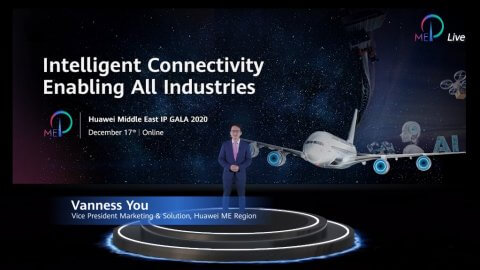Dubai, UAE, 17 December 2020: Huawei Technologies Co. Ltd hosted the second edition of the Middle East IP GALA Summit. Held virtually, the summit entitled “Intelligent Connectivity, Enabling All Industries” saw the participation of Huawei IP product line experts, IDC analysts, and leaders from mainstream carriers in the Middle East.
During the summit, some of the hottest topics in the IP industry were discussed, including digital transformation requirements, network evolution challenges and technologies, and more.
In his opening speech, Vanness You, Vice President of Huawei ME Marketing and Solutions, said: “Industries in the Middle East are on the path to digital transformation and new services such as VR, AR, 5G will change human society. Network is the foundation empowering all Industries and is the key to unleashing potential. As more aggressive services come in to cater to the SLA requirements, it’s quite essential that we continue our research in networking technologies such as slicing, intelligence, and programmability along with engineering methodologies and system architecture”.

Kevin Hu, President of Huawei Datacom Product Line, shared Huawei’s vision of building a better connected and intelligent Middle East. During his speech, he emphasised on the significance of digital transformation and how carriers would become a key enabler.
The massive rollout of 5G use cases, adoption of cloud and increasing end-user service experience expectations require an intelligent IP network that can provide ubiquitous capacity, seamless experience, and IPv6+ technologies.
Hugh Ujhazy, Vice President of IDC Telecommunications and IoT, introduced the standards of KAI bearer networks for the 5G era.
According to IDC, the combination of DX technologies (5G, cloud, IoT, and AI) would have a significant impact on all industries. Based on IDC research, telecom carriers face four challenges: surge in traffic and connections, flat revenue, and rising OPEX and CAPEX. To achieve the optimal transport network, IDC proposed a comprehensive indicator model that measures the transport network in five dimensions: Congestion Free, Always On, Scalable, Simplified, and Intelligent (CASSI Model).
Tony Hu, Vice President of Huawei Datacom Product Line, introduced the Target IP network towards 2025. Carrier networks are undergoing many changes and need to clearly define the vision for the next 10 years. In-depth network convergence integrates mobile and fixed infrastructures to serve end-users and prepare for digital transformation of vertical industries in the future. From the perspective of architecture, Huawei proposes that the target IP network 2025 addresses all challenges and can guarantee a deterministic experience with intelligent operations.
Hacken Li, CTO of Huawei Datacom Product Line, introduced key technologies of next-generation intelligent IP networks. When it comes to autonomous vehicles, autonomous driving networks require 400GE and hardware slicing for a wider road with dedicated lanes, SRv6 as navigation, and iFIT as a sensor to bring massive data to the AI-based brain.
Carrier Pioneers such as STC Kuwait and Zain KSA introduced their network practices in building the next generation intelligent IP network.
As the summit concluded, carriers and industry experts agreed on how to drive the network transformation towards an intelligent era. Huawei reiterated its commitment towards cooperating with carriers and partners in building an intelligent IP network that can achieve a win-win future.





